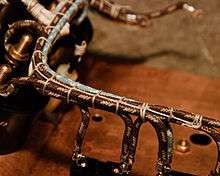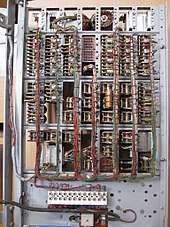Cable lacing
Cable lacing is a method for tying wiring harnesses and cable looms, traditionally used in telecommunication, naval, and aerospace applications. This old cable management technique, taught to generations of linemen,[1] is still used in some modern applications since it does not create obstructions along the length of the cable, avoiding the handling problems of cables groomed by plastic or hook-and-loop cable ties.

Cable lacing uses a thin cord, traditionally made of waxed linen, to bind together a group of cables using a series of running lockstitches. Flat lacing tapes made of modern materials such as nylon, polyester, Teflon, fiberglass, and Nomex are also available with a variety of coatings to improve knot holding.[2]

Styles
The lacing begins and ends with a whipping or other knot to secure the free ends. Wraps are spaced relative to the overall harness diameter to maintain the wiring in a tight, neat bundle, and the ends are then neatly trimmed. In addition to continuous or running lacing, there are a variety of lacing patterns used in different circumstances. In some cases stand-alone knots called spot ties are also used.[3] For lashing large cables and cable bundles to support structures in telecommunications applications, there are two named cable lacing styles: the "Chicago stitch" and "Kansas City stitch".[4]
Some organizations have in-house standards to which cable lacing must conform, for example NASA specifies its cable lacing techniques in chapter 9 of NASA-STD-8739.4.[5]
Examples
 Traditional waxed cord lacing made with a series of running lockstitches based on the figure-eight knot
Traditional waxed cord lacing made with a series of running lockstitches based on the figure-eight knot This style of continuous lacing, also called "marline hitching", is based on a series of overhand knots. A series of half-hitches, while visually similar, is not recommended for this application.
This style of continuous lacing, also called "marline hitching", is based on a series of overhand knots. A series of half-hitches, while visually similar, is not recommended for this application. Spot ties formed with a clove hitch topped by a reef knot made in modern Nomex lacing tape. A surgeon's knot is an acceptable substitute for the reef knot.[7]
Spot ties formed with a clove hitch topped by a reef knot made in modern Nomex lacing tape. A surgeon's knot is an acceptable substitute for the reef knot.[7] A variety of lacing techniques are visible on the cabling of the NASA Mars Exploration Rover Spirit and its lander.
A variety of lacing techniques are visible on the cabling of the NASA Mars Exploration Rover Spirit and its lander.
Notes and references
- "Cable Sewing Knots", Popular Mechanics, Hearst Magazines, 7 (5): 550, May 1905, ISSN 0032-4558,
Every lineman should know how to sew these knots.
- Gudebrod, Inc. "Braid Lacing Tape". Archived from the original on December 1, 2007. Retrieved 2008-07-08.
- Matisoff, Bernard S. (1987). Wiring and Cable Designer's Handbook. Summit, PA: TAB Books. pp. 93–106. ISBN 0-8306-2720-0.
- Qwest Corporation. "Qwest Corporation Technical Publication - Telecommunications Equipment Installation Guidelines" (PDF). pp. 5–19 – 5–24. Retrieved 2008-07-08.
- See "External Links" section for these documents.
- "Cable and Harness - General Requirements". NASA. 5 April 2002.
External links
| Wikimedia Commons has media related to Cable lacing. |
- NASA Technical Standard NASA-STD-8739.4 on Crimping, Interconnecting Cables, Harnesses, and Wiring
- "Workmanship Standards Pictorial Reference for NASA-STD-8739". NASA. Archived from the original on 2009-07-12.
- Online excerpt from Electronic Installation Practices Manual (1951) , "Chapter 9, Cabling"
- Online excerpt from Workmanship and Design Practices for Electronic Equipment (1962)
- Cable lacing tutorial using modern lacing tape
- History, tools, and techniques
- FAA Advisory Circular 43.13B paragraph 11-158